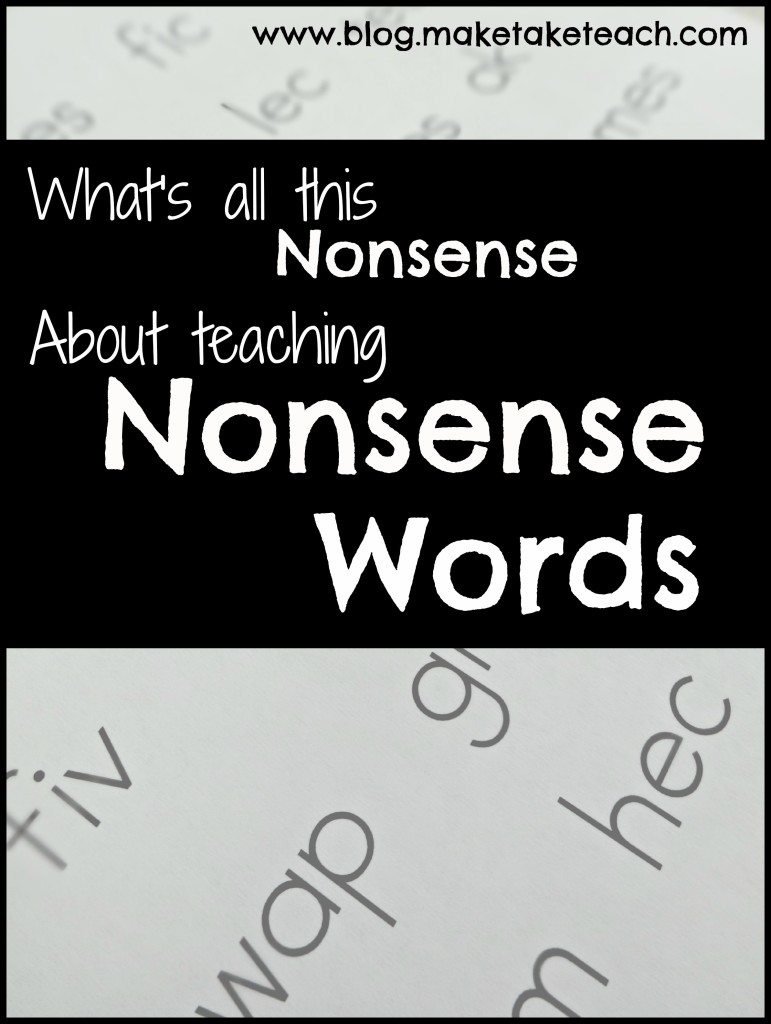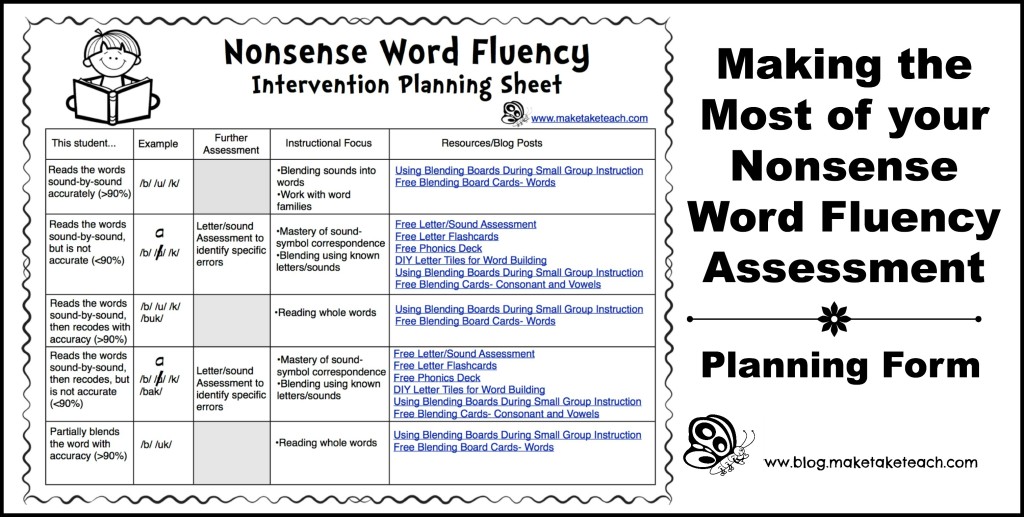It’s been nearly 10 years now that our schools have been using the Dynamic Indicators of Early Literacy (DIBELS) Next as a school-wide reading assessment. DIBELS was first introduced as part of Reading First and fit so nicely into our new Response to Intervention initiative. The DIBELS Next is a valid and reliable screener that can identify students at-risk for reading difficulties. The idea is that if we can identify those students early, we can put in place interventions to actually prevent the reading problem! Personally, I love this assessment. It does exactly what it is suppose to do. In the ensuing years; however, misunderstandings of the assessment have lead to inappropriate use of the data as well as inappropriate instructional practices. One of the issues I have surrounds the use of the Nonsense Word Fluency assessment.
What is the Nonsense Word Fluency Assessment?
Nonsense word fluency measures a student’s ability to decode individual phonemes (use of the alphabetic principle) and then blend the sounds together to read words. There is a large body of evidence that supports the use of pseudowords (nonsense words) for assessment purposes. According to research (Ravthon, N., 2004) “pseudoword decoding is the best single predictor of word identification for poor and normal readers” and is the “most reliable indicator of reading disabilities” (Ravthon, N, 2004; Stanovich, 2000). The assessment is really that powerful and when you administer the assessment, you glean a lot of information on the child’s mastery of the alphabetic principle as well as his/her ability to blend sounds into words. On the DIBELS Next NWF assessment, the student is given a page of “nonsense words” (pud, dak) and essentially asked to read the words. Some students are able to read the whole words (/pud/, others say the sounds (/p/ /u/ /d/), and some use onset-rime (/p/ /ud/). The assessment is a one minute assessment and the assessor records sound errors as well as if and how the student blended the sounds. A score is recorded (22 correct letter sequences/3 whole words read) and then compared to a set standard for the student’s grade. Using this score, the teacher can determine if the student’s ability falls within the benchmark (doing fine), strategic (require some additional instruction) or intensive (significantly at-risk) range.
Why is the NWF assessment timed?
All the DIBELS assessments are timed. This is because we want to not only assess whether a student is accurate with their sound-symbol correspondence, we what to know if the student has learned the letters and sounds to automaticity. In other words, are they so good at their letters and sounds, they can quickly and easily say the letter sounds. Students may be somewhat accurate with their letters and sounds, but if they are unsure and slow, their ability to read text and decode unknown words efficiently will be affected.
Purpose of the Nonsense Word Fluency Assessment
The presenter at my training many years ago said something to the effect of “nonsense words are used more for assessment and not as an instructional target”. In other words, the ultimate goal is not for students to read make believe words. The purpose of the assessment is two-fold. First, we want to know if the child knows the most common sounds for the letters and, second, we want to know if the child can blend the letters together to form words. Real words cannot be used because there would be no way of knowing whether the child is recognizing the word by sight, therefore, we are not isolating the skills that we wish to assess. It is important to think of the student’s performance on the NWF as an “indicator” of the child’s understanding of the alphabetic principle as well as the ability to blend sounds into word. The DIBELS Next is a screening assessment. The assessments are predictors of later reading performance. Below benchmark performance on the NWF assessment is an indicator that the student does not have mastery of the alphabetic principle and/or is not yet proficient at blending.
Use of Nonsense Word in Instruction
Let’s use the medical model to help us understand the use of nonsense words in instruction. Last year I went to my family physician for a physical. A series of routine screening tests were performed. Based on the results of those tests, it was determined that I had high cholesterol. Now, I don’t “work” on my cholesterol number. I work on the factors that contribute to a higher than desired cholesterol (diet, exercise). Same holds true with the use of nonsense words. Students don’t necessarly need to “work” on nonsense words. They need to work on the skills necessary for quick and accurate decoding unknown words (alphabetic principle, blending). It is always helpful to analyze a student’s performance on this measure. Analysis of the errors as well as if and how the student blended words helps when planning intervention. Here’s a planning sheet to get you started:
Click the following link to download this 2-page freebie NWF Planning Form
So with this in mind, here are a few more thoughts and ideas:
- It important to know that students who are automatic and accurate with their letters and sounds and who can blend sounds together will do well on the DIBELS Next NWF assessment even if nonsense words were never used during your instruction. Be sure your students are solid with their sound-symbol correspondence. Whether using nonsense words or not within your instruction, be sure provide explict and systematic instruction with blending.
- Your NWF data can be used to quickly identify sound errors as well as identify where your student falls on the word-blending continuum. You will want to use this data (as well as other data available to you) to group students into skill-based groups. Refer to the following chart.
- The progress monitoring component of the DIBELS Next NWF assessment is extremely valuable. You will want to be sure you progress monitor your students to ensure that they are progressing. You will want to change your instruction based on ongoing assessment.
- Some teachers choose to use nonsense words during instruction and other do not. If you are using nonsense words, just be sure that you are not over-using them. The vast majority of your instruction (really, vast majority) or your phonics instruction should include the use of real words and within context. Personally, I find using nonsense and real words while teaching the skill of blending during directed small group instruction is helpful as you can informally assess during instruction, have more opportunities for practice of a specific skill and move at a faster rate of presentation. See Using Blending Boards Blog post.
- I would caution the use of nonsense words during independent literacy centers. If a student can read a nonsense word as a whole word, there really is no need for him/her to practice reading nonsense words in a center. These students should be reading words in connected text. Reading nonsense words is not the best use of instructional time. If a student is inaccurate or is not blending, he/she needs direct teaching of the skill with immediate and corrective feedback. If the student has errors by placing a nonsense word fluency activity in a center you run the risk that the student will be practicing letters/sounds incorrectly. Students who are not blending will need explicit scaffolded instruction on this skill. This cannot occur in an independent center.



Leave a Reply